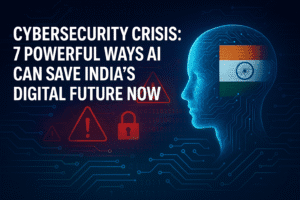Cybersecurity Crisis: 7 Powerful Ways AI Can Save India’s Digital Future Now
India’s rapid digital transformation, driven by initiatives like Aadhaar and UPI, faces a growing cybersecurity crisis as attacks surge and adversaries deploy AI-enhanced tactics. Traditional defenses are no longer sufficient, necessitating a shift to autonomous, AI-powered security operations centers that can predict and neutralize threats in real time. Generative AI tools democratize defense by empowering under-resourced teams with actionable insights, addressing India’s looming cybersecurity skills shortage.
However, trust and privacy concerns require a balanced human-AI partnership guided by transparent, explainable algorithms aligned with India’s data protection laws. Key challenges include bridging the skills gap, integrating fragmented security systems, and updating outdated regulations to accommodate AI ethics and cross-border risks. Embracing AI as a strategic asset, India can transform cybersecurity from a liability into a growth enabler, ensuring digital trust crucial for its $5 trillion economic vision. Public-private collaboration and fast-paced innovation are vital for outpacing evolving threats and securing India’s digital future.

Cybersecurity Crisis: 7 Powerful Ways AI Can Save India’s Digital Future Now
India’s digital revolution, marked by initiatives like Aadhaar and UPI, has positioned it as a global tech powerhouse. Yet, this growth comes with a mounting challenge: cyber threats are evolving faster than traditional defenses can counter. With cyberattacks surging by 30% in Q2 2024 and adversaries leveraging AI-driven tactics, the question isn’t if India needs autonomous cybersecurity—it’s how urgently.
The Rising Storm: India’s Cyber Threat Landscape
India’s digital economy, projected to reach $1 trillion by 2030, is a prime target. Chinese state-sponsored hacking groups exploit vulnerabilities in IoT devices, while ransomware cripples healthcare and financial systems. Polymorphic malware and deepfake social engineering add layers of complexity. For instance, a 2023 breach in a major Indian hospital’s network disrupted patient care for days, highlighting the fragility of critical infrastructure.
Traditional, reactive models are obsolete. India’s defense must shift to AI-driven autonomy, capable of predicting and neutralizing threats in real time.
Autonomous SOCs: The Brain of Modern Cybersecurity
Imagine a Security Operations Center (SOC) that doesn’t just detect threats but anticipates them. Autonomous SOCs fuse machine learning, behavioral analytics, and natural language processing to analyze trillions of data points—from cloud logs to endpoint activities—transforming noise into actionable insights.
For example, platforms like Arctic Wolf process petabytes of data weekly, using AI models trained on decades of cyber incidents. This isn’t just automation; it’s a self-learning ecosystem that evolves with each attack.
Generative AI: Democratizing Cyber Defense
Large Language Models (LLMs) are game-changers. AI security assistants can now summarize threats, prioritize vulnerabilities, and even simulate attack scenarios in plain language. This is critical in India, where a projected shortage of 1.5 million cybersecurity professionals by 2025 threatens progress.
Consider a rural bank’s IT manager querying an AI tool: “How do I mitigate a phishing campaign targeting UPI users?” The AI cross-references global threat databases and local attack patterns, offering tailored steps—empowering teams without deep expertise.
Trust, Privacy, and the Human-AI Partnership
While AI offers speed, trust remains a hurdle. India’s Digital Personal Data Protection (DPDP) Act demands transparency, yet biases in algorithms or false positives could erode confidence. A hybrid approach—where AI flags anomalies and human experts validate decisions—ensures accountability.
Leading platforms now embed “explainable AI,” detailing why a threat was flagged, and comply with data sovereignty laws. For instance, healthtech firms using AI-driven endpoint protection can audit decisions, aligning with both DPDP and patient privacy needs.
India’s Readiness: Bridging Gaps to Secure Growth
Three hurdles stand out:
- Skills Gap: Upskilling is non-negotiable. Initiatives like CyberShikshaa (training women in cybersecurity) must expand, integrating AI literacy.
- Fragmented Tools: Many enterprises use disjointed systems. Adopting open XDR architectures unifies visibility, as seen in Tata Power’s integrated grid defense.
- Regulatory Lag: The 2013 Cyber Security Policy is outdated. A proposed cybersecurity ministry could modernize frameworks, addressing AI ethics and cross-border data risks.
The Path Forward: AI as a Strategic Asset
AI isn’t a luxury—it’s India’s equalizer against asymmetric cyber warfare. Startups like SentinelOne deploy behavioral AI to detect zero-day exploits, while RBI mandates AI-driven fraud detection in fintech. The goal? Transform cybersecurity from a cost center to a growth enabler.
Call to Action:
- Enterprises: Pilot AI-powered threat detection in high-risk sectors (e.g., energy, finance).
- Government: Fast-track regulatory sandboxes for ethical AI testing.
- Academia: Partner with global CERTs to build AI-centric cyber curricula.
Conclusion: Speed is Survival
India’s vision of a $5 trillion economy hinges on digital trust. By scaling autonomous defense—grounded in ethical AI and human expertise—the nation can outpace threats. The tools exist; the urgency is now. As Dan Schiappa notes, the future isn’t about readiness—it’s about velocity.
India’s journey mirrors global trends but demands localized solutions. By treating cybersecurity as a public-private collaboration, akin to its space program, India can model resilience for emerging economies. The next decade will test whether its tech stack can defend as boldly as it innovates.
You must be logged in to post a comment.